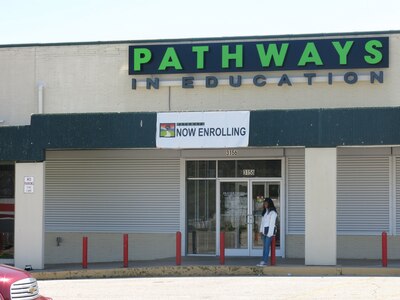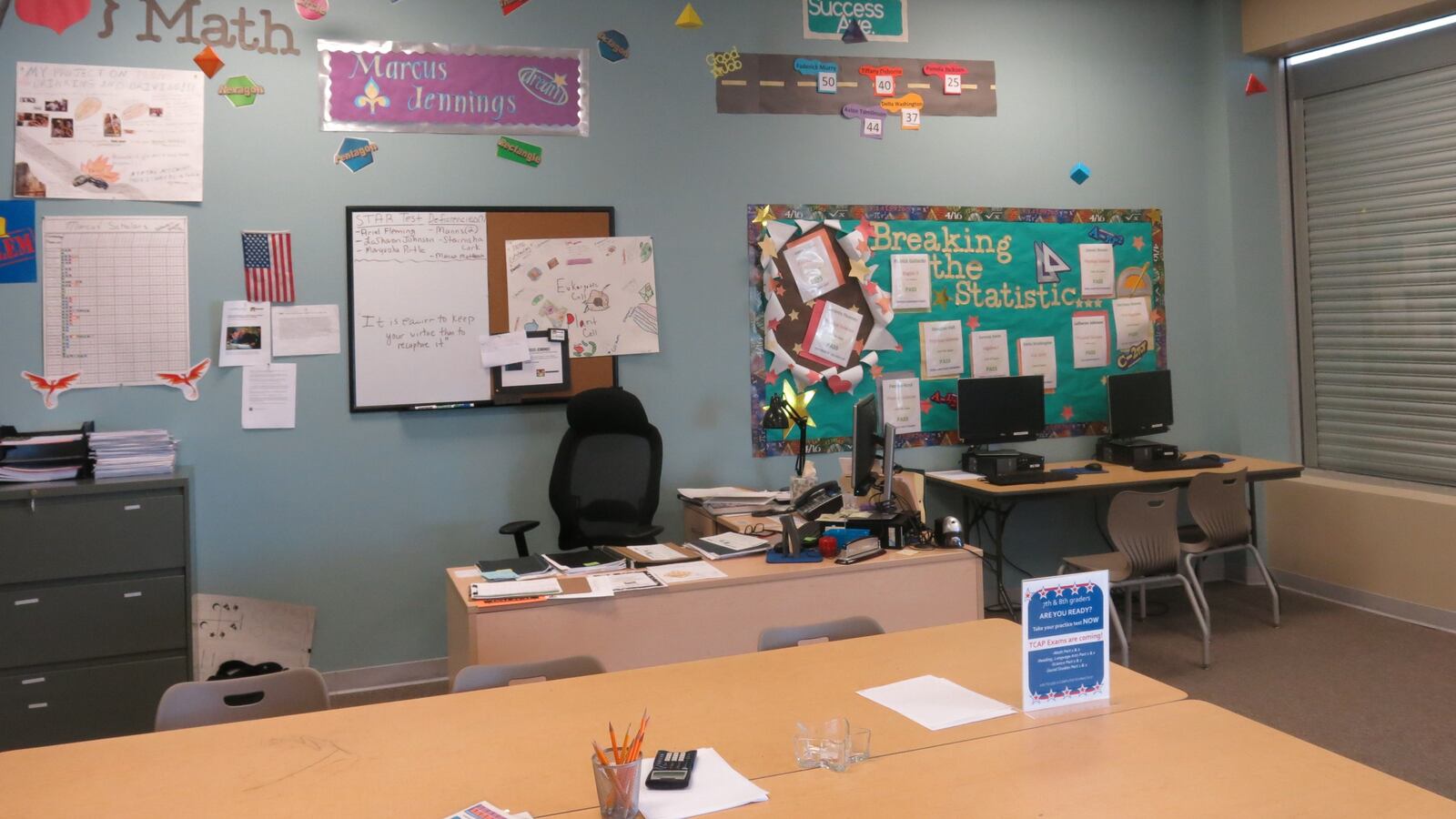The Achievement School District, which currently runs 15 schools in Memphis, opened its first alternative school this January.
Most schools in the Achievement School District (ASD) are former Shelby County Schools that are now being run as charter schools. The ASD has been tasked with taking schools ranked in the bottom five percent in the state – most of which are in Memphis – and improving them enough to push them into the top 25 percent in the state. But the new alternative school, Pathways In Education, started from scratch in a storefront in Frayser.
The first Pathways school was in Pasadena, Calif. The program has other campuses in California and in Chicago. Its other programs focus mainly on helping off-track or disconnected high schoolers attain their high school diplomas. Its Memphis program offers course recovery and classes for middle schoolers, high schoolers, and adults.

By early April, Pathways had 157 students in Memphis. Thirty percent were adults; 40 percent were high schoolers; and 30 percent are 7th and 8th graders, according to Jennifer Isom, the principal of the Memphis campus. Isom said 48 adults were on a wait list for the program.
There has been such demand that the district plans to open a second campus in Whitehaven this summer.
The ASD has about 4,000 students overall this year.
“We did some analysis to see where was still a need. There’s a lack of alternative options in Memphis,” said Margo Roen, the director of new schools for the ASD. “There’s no point when a family shouldn’t have a choice.”
“We also were looking at New Orleans, [where the state-run Recovery School District has a similar model to the ASD and found after several years that it needed to run alternative schools],” she said. “We are trying to be ahead of where they were and see (if) there is a need.”
Earlier this year, the ASD announced that it was looking to add alternative charter school operators in Shelby County. They did not get any applications this year, but Roen said she is hopeful that there will be qualified applicants in future years.
Roen said the school could only serve students zoned to schools ranked in the bottom five percent in the state. A bill that would allow students zoned to higher-performing schools to attend the ASD did not pass the state legislature this spring.
Below, Pathways’ principal, Jennifer Isom, talks about the program’s potential and challenges; an academic recovery teacher, Jackie Williams, describes her work; and Tarance Kearney, a student, talks about his experience at the school.
“There is such a need.” ~ Jennifer Isom, Principal
Jennifer Isom worked in Memphis City Schools and in local private schools before becoming a principal at Pathways. She says the program’s flexible scheduling and one-on-one attention is helpful for Pathways students.
Students in the program take one or two courses at a time. Students meet with teachers for a few hours a week and commit to completing much of the work at home. Those with special needs and IEPs get more time with teachers. In April, many Pathways students were also preparing to take the state standardized test.
Jennifer Isom describes Pathways’ programs:
The program has drawn attention from people around Memphis, Isom said:
The students are mainly from Westside and Humes [two ASD schools], but we have students from all over – Bartlett, Cordova, Craigmont. They’ve heard through word of mouth, or somebody read the newspaper. We have orientation meetings Mondays, Tuesdays, Thursdays and Fridays. We have 7-8 people come in each day and go through orientation with teachers and they enroll. That’s how we’ve grown so fast.
Isom said that charter schools tended to remand students at higher rates than regular district schools.
But the fastest-growing group at the school is adults. Jennifer Isom discusses how and why Memphis adults come to Pathways:
Pathways in Chicago and Los Angeles had traditionally focused on high schoolers. But the schools in Memphis also work with middle schoolers.
Part of the ASD contract was that we work with middle schooolers. Many students come, and they are 15 years old in 7th grade. Therefore I can say, the system has failed them. Someone let this student sit in the classroom and be failed multiple times, wasn’t able to give them the knowledge they need to be promoted. Many of those don’t even have an IEP (a plan for special education students.) And we’re like, why are you staying in 6th grade three times?
Using such an independent program with middle schoolers has presented some unique challenges, however. Pathways is planning to add small group teachers, but Isom says some of her youngest students may be better served in a more structured environment.
Isom describes the challenges in working with students who have been expelled or remanded from middle school school.
“This school is different.” ~ Tarance Kearney, student
Tarance, now 15, had been at Pathways for about 5 weeks in April. He was an 8th grader at Humes Middle School and was transferred to Pathways due to a combination of behavioral issues, clashes with teachers and administrators, and because he was too old for his grade, he said.
He wants to catch up on 9th- and 10th-grade coursework at Pathways and then go to a regular high school for his junior and seniors years of high school. Isom said many students want to have a “traditional” high school experience.
I went to Humes for 6th grade, and then my momma moved and I went to Westside. And then she moved again, so I went back to Humes. When I was there, I didn’t like it. This school is different.
How did you feel about coming to Pathways?
At first, I wanted to stay there. But I had to get in my right grade.
Tarance said he preferred the independence at Pathways.
Is it lonely working independently so much?
I feel okay because to be honest, I don’t love being around a lot of people. It makes me feel a certain kind of way. I like working independently.
How is it going so far?
I’m doing good – I learned science already, and I’m learning health and U.S. and world history now. I learned about volcanoes.
Your teacher told me each student has a goal. What’s your goal?
My goal is graduating out of school. And I want to play baseball.
When asked where he thought he would be if Pathways didn’t exist, he said,
I think I’d probably be in my same school. Or they would have moved me to the 9th grade.
Video: Tarance, a student, talks about Pathways:
“We are just here to give students an opportunity.” ~ Jackie Williams, academic recovery teacher and special education teacher at Pathways
Jackie Williams came to Pathways from Shelby County Schools.
I kept seeing this job posting, and initially I didn’t pay it any attention, but I kept seeing it. It seemed different from working in a traditional setting. …But eventually I thought I’d reply. And I got a call back! So of course I did my research – I googled and learned as much as I could about it…I met with a regional manager, we met downtown at a hotel because we didn’t even have a building yet. So it was taking a chance. But I really felt like there’s a need for it – there are so many students who are 17, 18, 19, they get to that age and they leave high school. So we want to give them a second chance.
Williams describes Pathways’ students:
Academic recovery is for students who are behind – a lot of our students are behind in terms of – for middle schoolers they may be grade levels behind, for high schoolers they may not have adequate credits for their grade level. They may be 18 or 19 and still only have a few credits. So we help them to recover credits. But we also have students who are not necessarily behind but who chose to come to Pathways for one reason or another For instance, we had a family and the mother said her kids had problems at their home school – there was a lot of bullying going on…It’s an option for parents who want to homeschool but want access to actual teachers. I have one student who was four credits away from a high school diploma. For him to have come so close to graduating, and then to end up with his GED – I think he would have wasted four years. So for people like him, this is a very beneficial program. You also have students who have continued to have behavioral problems and they even get kicked out of the regular alternative programs. This is an option for them. At Pathways, we don’t judge a student’s past. We are just hear to give people an opportunity.
The program requires a lot of flexibility from its teachers, who are working with middle schoolers and adults.
Our populations run from age 12 to their 50s. With our older students..they’re more responsible, they’re more mature, they want it more – but in many cases they’re even more behind. We have middle schoolers who came here because they thought that it would be like going to regular school but only two days a week. And it’s not that…it requires independence. So we are really working on parental involvement.
She says she thinks the students are learning. But there are some challenges.
It works well if a student is a fairly good reader: For high school students 5th grade level, for middle school students 3rd grade level – and that sounds low, but we do have a lot of people, a lot of children and some adults, who are reading on first and second grade level. For those students, we don’t have enough time in an hour, or even two hours, to go over a week’s worth of lessons. If a student can’t read, they won’t make progress here because so much of it is on their own. Schools don’t teach reading after 3rd grade. Students who have not learned to read at that point will struggle through school.
She said that she refers students who are so far behind pursue outside reading programs. “It’s hard,” she said.
Jackie talks about her experience at Pathways:
Update: The transcript of the conversation with Tarance Kearney has been updated.


